

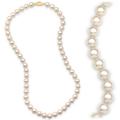

|
|
|
|
|
Blue Beads & June's Gemstone Pearl
Thanks to all those who visited us in Norwich, Luton and
Newcastle. If you're in the UK, you still have a chance to see us
today,
Sunday 1st June 2014 - Cheshire Bead Fair - Nantwich Civic Hall CW5 5D, or West
London the following week.
Make yourself
known for a MrBead bag & a free gift!
For details of all our 2014 bead fairs click here
If you
weren't mailed this newsletter enter your e-mail address
here
to receive next month's.
Blue - The World's Favourite
Colour
The Secrets of Pearls
What are
Cultured Pearls?
What is
Mother-of-Pearl?
Matching Pearls
Knotting a Pearl Necklace
How to Tell Real from Fake Pearls
£6 or $10 Discount Code
Tweet a link to this newsletter to all your
followers - just click
here.
Follow us on Twitter at MrBead@UKMrBead and follow
Nigel at Nigel@NigelMckay
Blue - The World's Favourite Colour
For jewellery, blue is the new lavender. Lorraine Cannell of The Bead Queen finds that the latest jewellery colour trend right now is blue - a cooling colour for an expected exceptionally-hot summer.
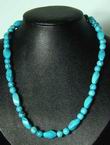

 Every colour has psychological properties relating to the
mind, body, emotions and the balance between these. Colour affects feeling and
moods. It also reveals ones personality as colours are use for self-expression.
Every colour has psychological properties relating to the
mind, body, emotions and the balance between these. Colour affects feeling and
moods. It also reveals ones personality as colours are use for self-expression.
Blue is an ‘intellectual’ colour for the mind and clear
communication. Bright blue is said to stimulate clear thought and lighter-blues
to calm the mind and aid concentration. Blue objects appear further then red
ones - perhaps explaining the colour’s ‘laid-back’ feeling, never gone out of
fashion on denim.
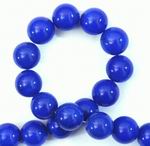

 New-agers say blue is a powerful antiseptic linked to the
throat charka - cooling inflammation, fever, and high blood pressure. It
represents peace and tranquillity, truth, wisdom, justice, femininity and rest.
The colour of the sea and sky, and used by disciplined career workers with a
clear direction in life.
New-agers say blue is a powerful antiseptic linked to the
throat charka - cooling inflammation, fever, and high blood pressure. It
represents peace and tranquillity, truth, wisdom, justice, femininity and rest.
The colour of the sea and sky, and used by disciplined career workers with a
clear direction in life.
Pastel cool colours suit summer-people with light hair, blue
eyes and pale skin best, but also look refreshing on everyone. Some of this
summer’s hottest blues are Placid Blue, Violet Tulip, Paloma and Dazzling Blue.


 Add some pastel and navy blue beads to your next jewellery
design. We have many semi-precious blue beads: like blue agates, quartz,
aquamarines, aventurine, amazonite, jade, pearl, chalcedony, turquoise and
lapis.
Add some pastel and navy blue beads to your next jewellery
design. We have many semi-precious blue beads: like blue agates, quartz,
aquamarines, aventurine, amazonite, jade, pearl, chalcedony, turquoise and
lapis.
To see our blue beads, simply key BLUE in our Search Box
at MrBead.co.uk
or MrBead.com
See The Bead Queens Original Designs at
TheBeadQueen.co.uk or
TheBeadQueen.com
The Secrets of Pearls

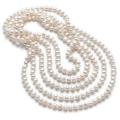
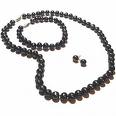
Pearl Jewellery Sells!
If you want to make quality, impressive jewellery that
everyone appreciates, then go for pearls. If you want to make quality, impressive
jewellery that everyone appreciates, then go for pearls.
Pearls are expected to be expensive and in short supply
The reason is that people understand pearls are natural. However, since the 1950s, natural pearls have been cultivated by man – making them much cheaper to buy.This means that including them in jewellery, you will make you even more profit!
The pearl is the queen of gems and the gem of queens
What are Cultured Pearls?
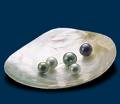
 The
least expensive cultured pearls today rival the most expensive natural pearls
ever found. Cultured freshwater pearls occur in mussels for the same reason
saltwater pearls occur in oysters. Foreign
material inside a mussel can't be expelled. To
reduce irritation, the mollusk coats the intruder with the same secretion it
uses for shell-building, nacre. To cultivate a pearl, farmers slit the mussel
and insert small pieces of live tissue from another mussel.
The
least expensive cultured pearls today rival the most expensive natural pearls
ever found. Cultured freshwater pearls occur in mussels for the same reason
saltwater pearls occur in oysters. Foreign
material inside a mussel can't be expelled. To
reduce irritation, the mollusk coats the intruder with the same secretion it
uses for shell-building, nacre. To cultivate a pearl, farmers slit the mussel
and insert small pieces of live tissue from another mussel.
The ancient Chinese practiced this technique, but the first real cultured freshwater pearls originated from Japan in the 1930's.Japanese farmers by Lake Biwa achieved natural colours previously unseen in saltwater pearls. However, water pollution today has virtually destroyed pearl production there.
 China now has the resources that Japan
lacks: many large lakes, rivers, and a low-cost work force. China has now revolutionized pearling - shapes, lustre, and
colours of Chinese pearls now surpass Biwa quality. Copying the Japanese to
improve off-white and mottling, China uses a mild bleach, bright lights, and
heat. Natural freshwater pearls are usually odd shapes. So for more roundness,
they reshape rejected pearls into spheres, and then nucleate mussels with them.
China now has the resources that Japan
lacks: many large lakes, rivers, and a low-cost work force. China has now revolutionized pearling - shapes, lustre, and
colours of Chinese pearls now surpass Biwa quality. Copying the Japanese to
improve off-white and mottling, China uses a mild bleach, bright lights, and
heat. Natural freshwater pearls are usually odd shapes. So for more roundness,
they reshape rejected pearls into spheres, and then nucleate mussels with them.
Colour Pearls
 Freshwater pearls are
popular for their colours: white, silvery-white, pink, red, copper, brown,
lavender, purple, green, blue, and yellow. The most desirable are the pastel
pinks, roses, lavenders, and purples. Natural
colour comes from the mussel species and water quality – with pearls taking the
colour of the shell in which they form. However, permanent dyes are used today for most saturated
colours.
Freshwater pearls are
popular for their colours: white, silvery-white, pink, red, copper, brown,
lavender, purple, green, blue, and yellow. The most desirable are the pastel
pinks, roses, lavenders, and purples. Natural
colour comes from the mussel species and water quality – with pearls taking the
colour of the shell in which they form. However, permanent dyes are used today for most saturated
colours.
The Best Pearls
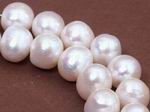
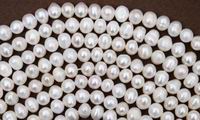 Good pearls have thick overlapping layers of nacre. This can be tested by viewing its "lustre". Roll the pearl with a pen in good light - the best pearls will reflect the pen the most. A large pearl is only more valuable if it's the same quality as a smaller one - the rounder the better. Being an organic gem, grooves, pits, or dents are expected.
Good pearls have thick overlapping layers of nacre. This can be tested by viewing its "lustre". Roll the pearl with a pen in good light - the best pearls will reflect the pen the most. A large pearl is only more valuable if it's the same quality as a smaller one - the rounder the better. Being an organic gem, grooves, pits, or dents are expected.
What is Mother-of-Pearl?
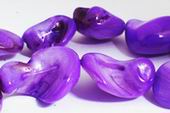 The shining, playful, reflected light of mother-of-pearl has attracted attention
since ancient times. From then,
different technology has turned mother-of-pearl into many uses, apart from
jewellery. Today, it’s dyed every colour under the sun - creating attractive
jewellery at affordable prices.
The shining, playful, reflected light of mother-of-pearl has attracted attention
since ancient times. From then,
different technology has turned mother-of-pearl into many uses, apart from
jewellery. Today, it’s dyed every colour under the sun - creating attractive
jewellery at affordable prices.
The mollusk forms mother-of-pearl as a protective shell. Like the pearl it’s a secretion of the mantle, composed of alternate layers of calcium carbonate and conchiolin. Among the chief sources are pearl oysters from the tropical seas.
Matching Pearls
Matching pearls isn’t
easy, but is important when planning jewellery. It’s an art in itself, requiring a sharp eye, excellent judgment, and
experience. Try to buy all the pearls for a project at the same time, as later
batches may not match your original purchase. When balancing pearls for jewellery, you need to consider:
How the pearls blend together in colour, shape, lustre, size and surface perfection.
How smooth the size increase is of pearls in graduated strands.
If a necklace is part of a set, all of its pearls on earrings, bracelets or whatever, must match. However, don’t put too much attention perfectly matching against other factors.
Knotting a Pearl Necklace
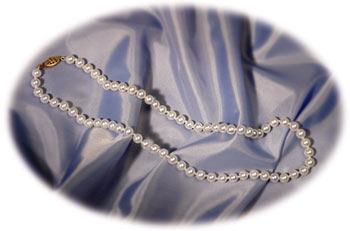 If
you look closely, you’ll see tiny knots in between each pearl on a good
necklace. This prevents the pearls rubbing against each other - and if the
necklace breaks, beads won’t go flying. Knotting also makes the necklace drape
nicely and adds length so you need less pearls.
If
you look closely, you’ll see tiny knots in between each pearl on a good
necklace. This prevents the pearls rubbing against each other - and if the
necklace breaks, beads won’t go flying. Knotting also makes the necklace drape
nicely and adds length so you need less pearls.
Pearls should be restrung every few years, depending on the amount of wear and exposure to hair spray, perfume, body oils, lotions, moisture, and perspiration they receive. These elements can weaken the silk and cause a potential break point for the strand.
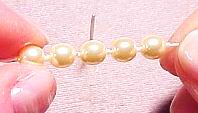 There are a few ways to knot a beaded necklace, but I’ll
only tell you the easiest for beginners. First, you’ll need to choose a type of
cord to use. There are two types that are usually used for knotting: silk and
nylon. Silk is traditional, however many complain that it snags and frays. Nylon
cord can also be used. Both come in a variety of colours.
There are a few ways to knot a beaded necklace, but I’ll
only tell you the easiest for beginners. First, you’ll need to choose a type of
cord to use. There are two types that are usually used for knotting: silk and
nylon. Silk is traditional, however many complain that it snags and frays. Nylon
cord can also be used. Both come in a variety of colours.
They can be purchased on small cards with about 6 feet of cord and a needle attached or, for the serious knotter, larger spools can be purchased with separate needles. They also come in different sizes. The thicker cord is used for the larger beads since the holes in the beads are larger. For the beginner’s technique, two strands are put through each bead, so a thinner size is needed. For 6mm beads, use size 2 for this technique, and try to match the colour of the cord with the colour of the beads.
A very-popular way to start any beaded necklace is with bead tips (clamp shells). The only difference here is that two strands of the cord are inserted through the bead tip instead of one. Once the necklace is started, string on a bead, and make an over hand knot. Make the knot tight so it’s snug up against the bead. Continue to do this: string a bead, make an over hand knot, string a bead, make an over hand knot. That’s it. Finish the necklace as you would any beaded necklace whether it’s knotted or not. This beginner’s way is a lot easier than using one strand of cord, and the results look almost the same. top of page
How to
Tell Real from Fake Pearls
Name
You can identify fake
pearls by what they’re called: simulated, faux, glass, plastic, resin,
artificial, manmade. Genuine pearls will be called natural, cultured,
freshwater, or sea.
Natural
Real
pearls may come from either freshwater or saltwater, and it’s very difficult to
tell which - both form in a variety of molluscs (not just oysters).
However, all grow the same way in
baroque shapes as well as round. There are also shell pearls and genuine pearls
which have been artificially coated or dyed. Before
you deal in pearls, you need to know if they’re natural or not.
Professional testing
If you want to buy expensive pearls that are perfectly matched, a
gemmologist certificate (from one of your choice) is essential. It costs about
£100 to have pearls tested, as opposed to several-thousands for the type
that warrant the test. An x-ray will show variations in density the inside of
the pearl, a parasite that might have caused the formation of a natural pearl,
and the characteristic shapes of drill holes.
The Tooth Test
 Rub
the surface of the pearl over your teeth - a real pearl feels gritty, while a
faux pearl feels smooth. Real pearls are
made up of layers of nacre that are deposited like sand on a beach. The slight
waves in the nacre give a bumpy feeling against the teeth.
However, if the pearls are dyed, the dye
can fill in natural depressions.
Rub
the surface of the pearl over your teeth - a real pearl feels gritty, while a
faux pearl feels smooth. Real pearls are
made up of layers of nacre that are deposited like sand on a beach. The slight
waves in the nacre give a bumpy feeling against the teeth.
However, if the pearls are dyed, the dye
can fill in natural depressions.
Close Inspection


 Look
at the pearls in bright light. Unless they’re very expensive, genuine pearl There
will be slight variations in shape, size and colour - along with grooves in their
nacre, bumps, ridges, or pits. Otherwise,
or if any are a perfect sphere or have a grainy smoothness: they’re suspect.
Look
at the pearls in bright light. Unless they’re very expensive, genuine pearl There
will be slight variations in shape, size and colour - along with grooves in their
nacre, bumps, ridges, or pits. Otherwise,
or if any are a perfect sphere or have a grainy smoothness: they’re suspect.
Cutting a pearl open will reveal its true nature. Natural pearls are comprised of many layers of nacre. Cultured pearls have a mother-of-pearl shell core covered with a thin layer of nacre. Fake pearls have a core with one or more layers of coating which tends to flake away on cutting.
Pearl Holes
Examine drill holes to see the
nacre layers and what lies beneath. Real
pearls are usually drilled from both sides to meet in the middle - making the
hole appear wider at the outside edge of the pearl. Holes of fake pearls are usually strait and are more likely to be larger
all the way through. The nacre of
fake pearls near the drill holes, flakes away easier than on a natural pearls.
And cheap real pearls may not be drilled straight, making a necklace hang badly,
unless it’s knotted.
Other Clues
Sometimes
fakes are made to look irregular, and glass pearls often have flattened ends.
Genuine pearls warm to the skin faster
than glass pearls - while plastic pearls tend to feel warm right away. And real
pearls are usually heavier for their size than any fakes.Other
signs are in the pearl’s surroundings. A
genuine pearl necklace is more likely to be knotted and set in gold, silver, or
platinum. You can examine clasps for stamps in the metal or for magnetism
(indicating iron as opposed to a precious metal). The clasp should have a safety
mechanism, like a fish hook. No one would use insecure clasps on good pearls.
Faux
pearls
 Faux pearls,
although manmade, are not necessarily a cheap substitute to the real thing. They have genuine beauty of their own, looking “almost” the same as
natural pearls costing thousands of dollars. They’re created by coating
the outside of glass or plastic beads with essence d’orient or pearl powder. This is then dipped into various solutions of pearl film to simulate the
lustre of a natural pearl.
Faux pearls,
although manmade, are not necessarily a cheap substitute to the real thing. They have genuine beauty of their own, looking “almost” the same as
natural pearls costing thousands of dollars. They’re created by coating
the outside of glass or plastic beads with essence d’orient or pearl powder. This is then dipped into various solutions of pearl film to simulate the
lustre of a natural pearl.
Pearl folk lore
 There are an almost infinite number of myths and folk lore
associated with pearls. Many pearl web sites included their own version of pearl
myths. Here are a few that I found:
There are an almost infinite number of myths and folk lore
associated with pearls. Many pearl web sites included their own version of pearl
myths. Here are a few that I found:
• Pearls have the powers of love, money, protection, and luck.
• Pearls were dedicated by the Romans to Isis and they
were worn to obtain her favour.
• In early Chinese myths, pearls fell from the sky when
dragons fought among the clouds.
Pearl
care
 Special
care is needed for pearls. Since they are naturally porous, it’s important to
make sure they do not absorb cologne, hair spray, lotions, or make up. Although
oils from your skin help keep the pearls from drying out. Pearl jewellery is
often purchased in a silk or felt pouch. You should keep the pearls in this to
prevent scratches. To clean pearls, don’t use any jewellery cleaners – wipe gently
with a damp cloth.
Special
care is needed for pearls. Since they are naturally porous, it’s important to
make sure they do not absorb cologne, hair spray, lotions, or make up. Although
oils from your skin help keep the pearls from drying out. Pearl jewellery is
often purchased in a silk or felt pouch. You should keep the pearls in this to
prevent scratches. To clean pearls, don’t use any jewellery cleaners – wipe gently
with a damp cloth.
We have really a lot of pearls in stock - click either MrBead.com or MrBead.co.uk
See us in the UK for a Free Gift!
After being shut away in a little office reading and sending e-mails, we love to see customers!
Visit us in the UK and say you're a MrBead Newsletter reader, and we'll give you a MrBead bag & a free gift!
Sunday 1st June 2014 - Cheshire Bead Fair - Nantwich Civic Hall CW5 5D
Sat &
Sun 7th-8th June 2014 - Gem 'n' Bead Fair, Kempton Park Racecourse, Sunbury,
London TW16 5A
£6 or
$10
Discount Coupon
For
£6 or
$10
off anything in our bead stores, key code
PEARLBEADS in the box at checkout, and click "Redeem Coupon". Act NOW as
offer only valid until Friday 6th June 2014.
Only for use in our main bead stores at the below links, NOT for eBay or our MarketWorks store.
To see all our beads at MrBead click http://www.mrbead.com or http://www.mrbead.co.uk
To return to the top of this page click here